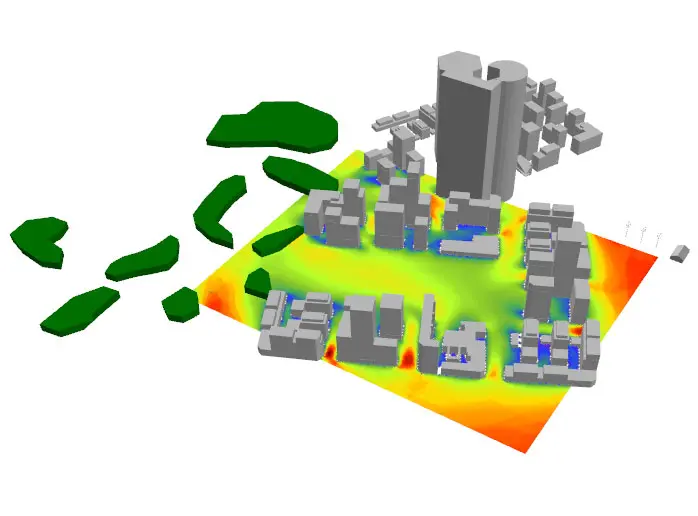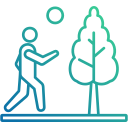UrbaWind
UrbaWind® is a software for the computation of local urban wind and 3D airflow modeling. It accurately simulates the wind flow and analyzes its characteristics in complex environments, including numerous buildings of various shapes as well as vegetation.
The CFD software for wind computation and modeling in urban environments
In an urban environment, the behavior of the wind becomes complex when it interacts with buildings, and various effects can occur: acceleration (Venturi effect), vortices, downdrafts, interference, separation, etc. The built environment creates a microclimate that is often a source of discomfort for users.
To achieve sustainable architecture and urban planning, it is crucial to study aerodynamic phenomena and integrate them early in the development of urban projects.
The UrbaWind® software enables users to calculate local wind and model 3D airflow. It features three modules, each dedicated to a specific theme: Pedestrian Wind and Thermal Comfort; Natural Ventilation; and Small Wind Turbines.

Computation and modeling of wind flows in built environments

Pedestrian wind and thermal comfort analysis
Its study is increasingly requested by project owners in numerous countries. Considering it is essential for the proper planning of an outdoor public space and the well-being of users. Webinar: Pedestrian wind comfort analysis with numerical tools ↘
Webinar: Properly use wind data in wind comfort analysis ↘
Features:
- Computation and mapping of wind comfort based on thresholds exceedance frequencies specific to country standards, with Gust Equivalent Mean (GEM) speed.
- Computation of thermal comfort statistics and Universal Thermal Climate Index (UTCI) using Grasshopper. Learn more ↘
- Identification of the discomfort sources and development of tailored solutions.
Natural ventilation potential estimation
Essential to bioclimatic construction, the natural ventilation should be considered when designing an energy-efficient building. It ensures a comfortable indoor temperature while reducing the need for air conditioning. Watch our webinar on natural ventilation assessment using CFD software ↘
Features:
- Optimization of the site plan to enhance the overall potential of the neighborhood.
- Calculation of indoor airflow and building air exchange rates.
- Optimization of the type and location of openings on facades.
Urban wind potential assessment
Urban small wind power is a renewable energy source that contributes to increasing the energy autonomy of buildings. Its integration can help to achieve the goals of positive energy buildings.
Features:
- Wind resource assessment.
- Computation of potential annual wind energy production
- Optimization of small wind turbines positioning.
Functions common to all 3 modules
- Automatic computation of wind flows.
- Seasonal or annual average wind maps.
- Modeling and educational visualization of physical phenomena
The power of CFD technology
The software relies on Computational Fluid Dynamics (CFD) technology and solves the Reynolds-Averaged Navier-Stokes (RANS) equations using an appropriate turbulence model.
This technology accurately simulates and analyzes the wind flow and its characteristics, even in complex environments with multiple buildings of varying shapes and vegetation.

Unmatched computing speed
UrbaWind® relies on a solver dedicated to wind computation. Its unmatched computing power and speed enable a better convergence of calculations.
The modeling is also optimized to conserve your computing resources while maintaining accuracy. The accuracy is further enhanced through automatic meshing, refined up to 50 cm near buildings, the ground, and result points.
Discover the features of UrbaWind® new version (2025)
Strengths
Integrated international databases
METEOROLOGICAL DATA
UrbaWind® simplifies your work by integrating a meteorological database from the international network of weather stations.
STANDARDS AND RECOMMENDATIONS
The software also includes a catalog of international standards and recommendations related to pedestrian comfort and wind safety.
Simplified imports and exports
Import your 3D digital models in the universal STL format, and your wind data (time series and statistics) in Meteofrance, Energy+, or Meteonorm formats.
Easily leverage your results with exports to .csv and .txt format, and to dynamic thermal software (STD).
Project Assistance
Benefit from scientific expertise and in-depth analysis of your projects. Our team of experts is available to assist you.
Testimonials
WHITE PAPER – Pedestrian Wind Comfort
Moving from theory to practice, this white paper will guide you through the numerical evaluation of pedestrian wind comfort in urban environments and provide you with a comprehensive understanding of the subject.